
|
![]()
Greatest Films of the 1940s
1940 | 1941 | 1942 | 1943 | 1944 | 1945 | 1946 | 1947 | 1948 | 1949
Title Screen Film Genre(s), Title, Year, (Country), Length, Director, Description 


The Accused (1949), 101 minutes, D: William Dieterle
This film noir was based upon June Truesdell's 1947 novel, "Be Still, My Love." The dramatic psychological crime thriller opened with psychology professor Dr. Wilma Tuttle (Loretta Young), a prim and proper teacher at a small Southern California LA college, at a Pacific Coast Highway beach in Malibu one evening. After hitching a ride home with a trucker Jack Hunter (Mickey Knox), Wilma slept restlessly and in the morning, she recalled - in flashback - entirely what had occurred the previous day. She had been fending off the flirtatious romantic advances of one of her students, handsome Bill Perry (Douglas Dick), a "bad boy" who came from a dysfunctional family. As they parked next to an isolated beach cliff, he changed into a bathing suit and then became sexually aroused (he called her a "little firecracker") - and attempted to rape her. She resisted, picked up a tire iron, and unintentionally beat him to death. To cover up the crime, she tossed his body over the cliff into the ocean, making it appear that Bill was diving into the water from cliff's edge. The overwhelmingly-distraught Wilma was anxious and guilt-ridden about the murder. She learned from Bill's guardian, lawyer Warren Ford (Robert Cummings), that Susan Duval (Suzanne Dalbert), a foreign exchange student in the same class who had unrequited love for Bill, claimed (falsely) that he had impregnated her, in order to get his attention. When Bill's body was found, skilled investigating detective Lt. Ted Dorgan (Wendell Corey) concluded that it was murder, and Susan became the prime suspect. To allay suspicion, Wilma began to date Warren (and soon, they became engaged), and she was fortunate that the trucker couldn't identify her. Forensics lab technician Dr. Romley (Sam Jaffe) concluded accurately that the killer had struck Bill on the head with a lethal blow, and then faked Bill's drowning. Wilma was having frequent anxiety attacks and outbursts. Detective Dorgan suspected that Wilma was the murderer - he knew she had copied a letter to Bill (that she had put on her door, but the janitor had thrown away) about cancelling a date to see him, in order to help establish her innocence. He also knew that Bill's last words were that he was going to meet with a "cyclothymiac cutie" - a phrase about a chronic mood disorder taken from one of Wilma's exam questions on personality. Wilma knew that Bill had described her as a repressed, prudish female in the exam, and she feared that she would be connected to Bill's death. With a subpoena to appear in court, Wilma confessed to the killing after re-enacting the murder scene. She was arrested, and Warren elected to defend her - arguing that the crime was committed in self-defense. In his closing argument, he convincingly argued that fearful Wilma's only crime was the cover-up. Detective Dorgan realized that the circumstances of the case, defended by the love-struck lawyer, would fully exonerate her.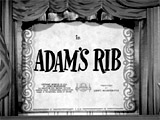



Adam's Rib (1949), 101 minutes, D: George Cukor
Director George Cukor's great, sophisticated, battle-of-the-sexes comedy was one of Hollywood's greatest classics. The comedy was often rated as the best pairing of the nine films of the legendary screen team of Tracy and Hepburn - it was their sixth film together. The film also skyrocketed the career of Judy Holliday who went on to play the lead role in Born Yesterday (1950). It told about husband-and-wife lawyers in the upper middle-class who were forced to compete against each other when they took opposite sides of a front-page court case. It featured a forward-looking, provocative screenplay with snappy dialogue by Ruth Gordon and Garson Kanin - the husband and wife's second collaboration with director George Cukor. The sophisticated film was originally titled Man and Wife, and was later remade into a 1973 TV series spin-off with Ken Howard and Blythe Danner. The opening scene was an attempted assault/murder of a philandering, two-timing husband Warren Attinger (Tom Ewell) by his scatterbrained, 'dumb blonde' wife Doris Attinger (Judy Holliday in her debut major film role) after reading an instruction manual about how to use a gun. The wronged Brooklyn housewife, a real bombshell, vengefully shot and wounded her husband Warren who was with his mistress Beryl Caighn (Jean Hagen) in a Manhattan apartment. Husband/wife Amanda and Adam Bonner (Katharine Hepburn and Spencer Tracy) were introduced as they revealed their different viewpoints about the sexes during an early driving scene in the city: (Amanda: "There are lots of things that a man can do and in society's eyes, it's all hunky-dory. A woman does the same thing - the same, mind you, and she's an outcast...All I'm saying is, why let this deplorable system seep into our courts of law, where women are supposed to be equal?"). A chauvinistic, law and order Asst. District Attorney, Adam was called upon to prosecute Doris Attinger for attempted murder - seen in the film's opening. Adam first learned of his savvy wife's role as defense attorney against him when she declared: "I'm going to defend her" - (he toppled and spilled a tray of drinks). She had volunteered to defend Doris (pro bono) with feminist, women's rights arguments. Amanda claimed that Doris had the same right (an "unwritten law") as a man to shoot a spouse when caught in adultery - the principle of equal justice. Her position angered Adam who felt his wife was upsetting sexist double standards. There were personal tensions on the homefront each evening between Amanda and Adam when the trial conflict moved into their home. The Bonners engaged in a confrontation on a massage table at home when he slapped her behind hard: ("What are you - sore about a little slap?" and her reply: "I know a slap from a slug"); and eventually Adam moved out. During the trial, Beryl testified that Warren was at the apartment to sell her an insurance policy, and that he never touched her. Doris testified that she found the two hugging together on the couch, and that she wanted to save their marriage and family (they had three children) - all she wanted to do was frighten Warren (and she did wound him in the shoulder), not injure him or Beryl. To bolster her case (although irrelevant), Amanda called three successful female witnesses to demonstrate equality of the sexes - her own political agenda. Adam's closing argument was weak, due to the fact that Amanda interrupted him with frequent objections to his claims that Doris was a criminal, and she also used persuasive theatrical tricks (a role-play scenario with reversed positions for Doris and Warren). She proved that the law would vindicate a man who would try to kill the lover of his unfaithful wife. Ultimately, the jury acquitted the simple-minded Doris, and Adam was forced to reluctantly admit that Amanda had presented an effective and contrasting point of view. At film's end, Adam finally and conclusively stated that there was very little difference between men and women - but then exclaimed that he did like that "little difference": "Vive la difference."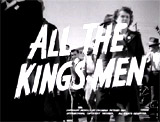


All the King's Men (1949), 109 minutes, D: Robert Rossen
The Best Picture-winning, hard-hitting film, a great political drama, was the melodramatic, film-noirish story of the corruption of power by an ambitious demagogue (with B-picture star Broderick Crawford in an impressive, electrifying, Oscar-winning breakthrough role) - it was adapted and based on the Pulitzer Prize-winning and best-selling 1946 novel of the same name by Robert Penn Warren, and filmed from a script by producer-screenwriter-director Robert Rossen (known for directing other films such as Body and Soul (1947) and The Hustler (1961)). Rossen's fictionalized account told of the rise and fall of backwoods, honest and naive rebel lawyer and poor rural farmer turned into a corrupt, dirty, unscrupulous, backstabbing, and sleazy politician - a story inspired by the rule (and despotic abuse of power) of Louisiana's colorful state governor (1928-32) and Democratic U.S. Senator (1932-35), the notorious Huey Long - better known as "The Kingfish" - who was only removed from office when he was assassinated. One of the film's posters proclaimed: "He thought he had the world by the tail...till it exploded in his face...with a bullet attached..." In the film's opening, young Chronicle newspaperman Jack Burden (Oscar-nominated John Ireland) was sent to report on a Southern politician named Willie Stark (Broderick Crawford) - an underdog running for County Treasurer of Kanoma County (in an unnamed state) in the late 1920s. Jack was taken to Stark's rural home to meet Willie's long-suffering ex-schoolteacher-wife (of nine years) Lucy (Anne Seymour), his father Pa Stark (H. C. Miller), and their sullen 15 year-old adopted step-son Tom (John Derek). Although Burden was impressed by Stark's honesty and thought favorably of him, others had conflicting points of view. At this time on an island community known as Burden's Landing, Burden proposed marriage to Anne Stanton (Joanne Dru), the socialite niece of patriarchal Judge Montgomery (Monty) Stanton (Raymond Greenleaf), but she turned him down. [Note: Anne Stanton was the sister of idealistic Dr. Adam Stanton (Sheppard Strudwick).] Willie lost the election to local politicos, but went on to acquire a self-taught law degree to become a hick lawyer. Then, he was encouraged to run for state governor by state bosses in the capital, but was really being manipulated by them to split the rural "hick" vote to allow their candidate to win. Stark's cool, conniving and calculating political aide Sadie Burke (Oscar-winning Mercedes McCambridge) knew that Stark was being framed and used as a decoy. Nonetheless, before losing, Stark delivered a rousing, memorable impromptu speech at the fairgrounds that truly spoke to the people ("Listen to me, you hicks!"). Four years later, Willie conducted a second campaign for Governor, and Burden was hired as his chief aide, hatchet man and speech writer. The shrewd Sadie Burke became his secretary and campaign manager - and his mistress on the side - and Willie made lots of behind-the-scenes deals to finance his winning campaign. Burden slowly became disillusioned and troubled as he observed Stark's corruptible rise to power as a demagogue ("strange deals" with special interests), his philandering, and his shady character. As part of his winning strategy, Willie appointed Judge Stanton to the office of Attorney General after taking power, but Stanton ultimately resigned after learning of Willie's coverup of many corrupt scandals and graft in his administration. However, during his reign, Willie improved the schools and roads, built power dams and retained the love of the people. As a charismatic governor, rising to the pinnacle of power, he established his own political machine and became as brutal, fascistic, fearsome, dirty, despotic, dishonest and corrupt as the crooks he had replaced. Willie was also cheating on his mistress Sadie, even taking his friend Jack's fiancee, an infatuated Anne, as his other mistress. Burden was assigned by Stark to dig up dirt on Stanton's background (he discovered that Judge Stanton was involved in wrongdoings many years earlier - a petty, but unsavory blackmail scandal to acquire a job) - and Anne betrayed her uncle by revealing Burden's uncovered information to Stark. Meanwhile, Stark was planning to eventually move on to the White House after another gubernatorial campaign, although he first had to endure an impeachment trial being conducted against him by the state legislature. Willie schemed to use the information discovered by Burden to confront reputable Judge Stanton who controlled the decisive impeachment votes of Senators who backed him. As a result, the disgraced Stanton committed suicide - off-screen. The film concluded with Stark's assassination by Anne's disgruntled and outraged brother Dr. Adam Stanton, who was upset over Anne's romantic involvement with Willie, and her betrayal of the Judge (by divulging to Stark "dirt" on the Judge's past dug up by Burden). He also indirectly blamed Stark for the suicidal death of his uncle. As the film concluded, Stark was acquitted in the impeachment hearings, and he emerged to deliver a victory speech to the hick crowd on the steps of the state capital building. There, he was gunned down by Adam, followed by Adam's death by Stark's accompanying bodyguard-henchman Sugar Boy (Walter Burke). After Anne and Burden both knelt over Adam's body, Burden tried to convince Anne to remain with him in the capital to reveal the truth about Willie to the crowd. Mortally wounded and dying on the steps, a dismayed Stark delivered his final words: "It could have been whole world - Willie Stark. The whole world - Willie Stark. Why does he do it to me - Willie Stark? Why?"


Battleground (1949), 118 minutes, D: William A. Wellman
Director William Wellman's solid, ultra-realistic, grim and authentic-looking war drama featured a star-studded cast. It was nominated for six Oscars (including Best Picture), with wins for Best Writing, Story and Screenplay (by Robert Pirosh, a veteran of the Battle of Bastogne), and Best B/W Cinematography. It was a milestone film - as the first significant post-WWII film in the US. It was dedicated to "the Battered Bastards of Bastogne" - referring to a WWII platoon of American troops in the elite 101st Airborne Division ("The Screaming Eagles"). The members of E Company became trapped at the strategic crossroads of the city of Bastogne in December, 1944 during wintry conditions - surrounded and outnumbered and awaiting their fate. The raw recruits were dug in behind the German lines during their last-ditch advance at the Battle of the Bulge (the Siege of Bastogne) in the Ardennes forest. The plotless story was told as a character study of the various stressed-out GI comrades and dogfaces from around the country (a representative and ordinary group of soldiers) - including their fears, hopes, light-hearted humor and courage. When caught in inclement weather (the "fog of war"), the infantry group was cut off from supplies (reinforcements of food, gas, medicine and ammunition) and military intelligence. They were forced to create foxholes in the snow, avoid German bombs ("incoming mail"), fight in hand-to-hand combat, and deal with Germans wearing American uniforms. At one point, the Germans appeared with a white truce flag, but were actually demanding that Brigadier General McAuliffe surrender, but he delivered a famous reply: "Nuts!" - of course, misunderstood by the Germans. The various characters who were serving their country included tough, tobacco-spitting lead Sgt. Kinnie (James Whitmore) who suffered from frost-bitten feet, wise-cracking paratrooper Pfc. Holley (Van Johnson), a religious Latino from LA (who wished to see snow) by the name of Pvt. Johnny Roderigues (Ricardo Montalban), Jarvess (John Hodiak) - an enlistee and small-town Kansas newspaper columnist, "Pop" Ernest J.S. Stazak (George Murphy) - the oldest member of the platoon, and innocent and idealistic rookie Pvt. Jim Layton (Marshall Thompson) - the film's narrator. An additional character was the Chaplain (Leon Ames) who delivered a moralistic sermon about the justified fight against Nazi fascism: ("And the $64 question is: 'Was this trip necessary?'"). There was also a side story involving Mme. Denise (Denise Darcel) when the squad was forced to stay in her apartment. Eventually when the skies cleared, the platoon survived after Allied fighter aircraft were able to attack, C-47s from the Third Army dropped parachutes with supplies, and they were relieved by fresh troops. The film concluded with their rhythmic cadence march, called out by Sgt. Kinnie as they left the battlefield and passed an arriving relief column.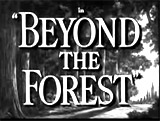


Beyond the Forest (1949), 96 minutes, D: King Vidor
King Vidor's muddled, far-fetched and absurd film-noirish melodrama featured an impressive score by Max Steiner. It starred the inimitable Bette Davis in her last film for Warners after 18 years. The main female protagonist was one of the baddest, trashiest, and most warped of all femme fatales in cinematic history. The story was told in flashback by a narrator, who introduced the character of Rosa Moline (Bette Davis) as "evil" - a suspect in a possible manslaughter case. The film reviewed the events that led up to Rosa's murder inquest, the context for her "evil" reputation, and the events that led up to an accidental murder. Black-hearted, unattractive hag Rosa was a Loyalton, Wisconsin mill town girl, married to a decent, saintly small-town Midwestern doctor Dr. Lewis Moline (Joseph Cotten). She was dissatisfied, bored, neglected, discontented, and repressed by small town life in the mill town, longing for and coveting big-city life and desperate for wealth. She complained: "If I don't get out of here, I'll just die! Living here is like waiting for the funeral to begin. No, it's like waiting in the coffin for them to take you out!" She snarled at her husband about their modest home - "What a dump!" (referenced in Who's Afraid of Virginia Woolf? (1966)). To escape her boredom, she first attempted adultery, engaging in a year-long, illicit, erotic love affair with a vacationing neighbor - wealthy Chicago industrialist/millionaire Neil Latimer (David Brian), while he was at his luxurious Latimer Lodge hunting facility near her hometown. She attempted to sexually entice and entrap him. However, after the promiscuous Rosa discovered that she was pregnant by her husband, she was forced to shoot and kill Latimer's cabin caretaker Moose Lawson (Minor Watson) to silence him, so that she could run away to Chicago with Latimer, who had reversed himself and now wanted to marry her. A coroner's inquest found her not guilty for the 'accidental' death, while she continued to keep the pregnancy a secret from Latimer. In fact, she attempted to abort her baby with an attorney (the result of a strange censorship demand) - then successfully induced a miscarriage by jumping down an embankment. Half-crazy, mad, feverish, and suffering from blood poisoning (peritonitis), she frantically continued to try to escape to Chicago to meet up with Latimer. Near the train station, she collapsed and died an agonizing death in the roadway before getting to the boarding platform.


Champion (1949), 99 minutes, D: Mark Robson
This all-time great boxing film and taut morality tale had six Academy Award nominations (and one win for Best Film Editing), including Best Actor for Kirk Douglas in a star-making role. It was based on the short story Champion by Ring Lardner that appeared in Metropolitan magazine in 1916. The story told about the ups and downs in the life of ruthless, loud-mouthed, thuggish, working-class boxing champ Michael "Midge" Kelly (Kirk Douglas) - seen in flashback. With his partially-disabled, crippled brother Connie (Arthur Kennedy), Midge was hitching westward and ended up in Kansas City after being picked up by boxer Johnny Dunne (John Day) and his good-time girlfriend Grace Diamond (Marilyn Maxwell). Midge was encouraged to enter a boxing match event for $35, and although beaten in the four-round bout, his raw talent attracted the attention of his future manager from LA named Tommy Haley (Paul Stewart). Later in Malibu, California, Midge was forced to marry waitress Emma Bryce (Ruth Roman) after getting her pregnant - a shotgun marriage demanded by Emma's enraged father. Shortly after, he deserted her and located retired trainer Haley in an LA gym, and began working his way up in the boxing ranks by winning matches. Although Haley ordered him to take a dive in a fight against top opponent Johnny Dunne, he knocked Dunne out in the first round. For his disobedience, he was viciously beaten by his irate handlers and other organized mob members. He began a relationship with seductive gold-digger Grace, an opportunistic moll who was secretly working for Jerome Harris (Luis Van Rooten), Dunne's promoter and manager (with ties to criminals), who eventually persuaded Midge to switch managers and abandon Haley. Midge was also having an affair with naive and spoiled Palmer Harris (Lola Albright), Harris' sculptor wife. Harris made a deal with Midge to end his affair with his wife Palmer, by forgiving his debts - and Midge agreed, breaking Palmer's heart. All along in his career and personal life, Midge continued to throw away his moral principles. He cruelly alienated, abused and mistreated all of his friends and family (and even the mob) who had stood by him, including his mother, Connie (now engaged to Emma, whom Midge raped off-screen before her divorce was final) and Palmer. With Haley rehired as his trainer-manager, he prepared to defend his championship title against comeback fighter Dunne. During the final rematch, it became a brutal fight. Midge was knocked down twice and had a severely-cut eye, but he fought to the end and knocked out Dunne in the last round. But then, bloodied and victorious, a triumphant Midge - with a battered face - collapsed and died of a brain hemorrhage in his dressing room. In the last line of the film, Connie faintly praised his brother to the press: "He was a champion. He went out like a champion. He was a credit to the fight game, to the very end."


Criss Cross (1949), 84 minutes, D. Robert Siodmak
This under-rated, fatalistic film noir from director Robert Siodmak featured unreliable characters, tenuous relationships, a diabolical and fatal love triangle marked by obsessive and doomed love, betrayal, and twisting plots. It was told with one major flashback and a self-deluding voice-over narration. Its tagline referred to the film's double double-cross: "When you Double-Cross a Double-Crosser...IT'S A CRISS-CROSS!" Under the title credits, the film opened with a striking aerial panoramic view of nighttime Los Angeles before the camera swooped down to a parking lot in the northern part of downtown LA where a doomed couple's trysting embrace was revealed by glaring headlights, near the Round-Up Bar. They were speaking about meeting up at a Palos Verdes cottage after a daring, unspecified plot that would unfold the next day. In a lengthy flashback, it told how love-sick, still-obsessed and infatuated ex-husband Steve Thompson (Burt Lancaster) had returned to his LA family two years after a 7-month marriage to calculating femme fatale Anna Dundee (Yvonne DeCarlo) before they divorced. He was again snared into her web in the Round-Up nightclub, when he saw his ex-wife dancing the rhumba (to the tune "Jungle Fantasy") with an unnamed partner (an unbilled Tony Curtis in his screen debut). Steve fatefully brooded: "Anna. What was the use? I knew one way or the other somehow I'd wind up seeing her that night." They rekindled their love after they took a swim in the early morning at Zuma Beach. Steve was warned to stay away from the temptress by his mother (Edna Holland). LAPD Lt. Pete Ramirez (Stephen McNally) also pressured Anna to leave town, when Anna suddenly eloped to marry abusive, crooked gangster boyfriend Slim Dundee (Dan Duryea). Nonetheless, Steve met up with her again and continued to engage in a clandestine affair. When caught together alone by Slim and his gang, Steve tried to deflect attention regarding their relationship. He quickly hatched a plan with Slim for a daytime payroll heist plan. Steve was expecting to double-cross Slim and escape with Anna after the robbery, but everything went horribly wrong - Steve shot Slim in the leg, but then was badly wounded himself. The gang fled with the money. Afterwards while he recovered in a hospital, Steve was viewed as a hero. In the film's dark, fatalistic and morbid finale, the still-recuperating Steve was taken from his hospital room in the middle of the night and driven to meet with Anna in their seaside Palos Verdes rendezvous. When Anna realized how weak he was, she became aggravated with Steve for spoiling their getaway, and began to think only of her own survival - she planned to quickly pack up and desert him. Slim had traced them to their seaside Palos Verdes rendezvous. He entered, taunted Steve: "You won out, Thompson. You've got her. She's all yours now," and then mercilessly gunned down both Anna and Steve with three gunshots, turned, and heard police sirens in the distance.

The Fountainhead (1949), 114 minutes, D: King Vidor
Warner Bros' black and white drama was based upon Ayn Rand's 1943 best-selling novel of the same name, who was hired to write the screenplay for the fictional film. The main thesis of the didactic book and film was the idea that individualism was superior to collectivism, conformity, and conventional interests, a notion known as Objectivism. The film's main character (modeled after famous architect Frank Lloyd Wright) that embodied pure individualism was visionary and uncompromising architect Howard Roark (Gary Cooper), who had been dismissed by an architectural school Dean (Paul Stanton) for being far too individualistic and for exhibiting originality. In contrast, opportunist fellow student Peter Keating (Kent Smith) planned on making a fortune as a hack architect by compromising and giving the public what they wanted. Roark's first employer Henry Cameron (Henry Hull) also advised Roark to compromise and give in to public tastes. As predicted, Roark faced little success and was doomed to fail in a world where individualism was detested. Later in the film as contrast, the city's newspaper The Banner had become a powerful and successful newspaper by catering to the public's cheap and tawdry tastes. Ellsworth Toohey (Robert Douglas), the architecture critic for The Banner, and the paper's publishing magnate Gail Wynand (Raymond Massey) had become rich and powerful due to their appeal to the masses. In contrast, socialite Dominique Francon (Patricia Neal) who was also a Banner columnist, admired Roark's designs and opposed the paper's campaign against him. Dominique was engaged to marry successful architect Peter Keating, at the same time that Wynand was in love with her. In the conclusion, Dominique was in a loveless marriage to Wynand, while Keating sought help from Roark to provide the design for a massive low-cost public housing project known as Cortlandt Homes. The resultant buildings (with unauthorized design changes to Roark's original design) were ugly, tasteless, and compositionally awkward. Feeling that the project had perverted his design, Roark dynamited the project. After his arrest and during his trial, Roark single-handedly delivered a powerful and convincing courtroom speech to vindicate himself and chastise collectivism: ("The world is perishing in an orgy of self-sacrificing") - and he was ruled not-guilty by the jury. A guilt-stricken Wynand, who had publically condemned Roark, now rewarded him with a contract to design a massive building in his own honor, and then committed suicide with a gun. The climax came with the reunion of Dominique (who had earlier already left her husband and was now Mrs. Roark) and Roark triumphantly atop his new, under-construction and unique Wynand Building skyscraper.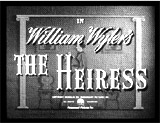

The Heiress (1949), 115 minutes, D: William Wyler
William Wyler's great but bleak romantic drama featured an icy musical score from Aaron Copland - it was based on Henry James' 1880 novella Washington Square and the 1946 play by Ruth and Augustus Goetz. It was remade as a TV movie in 1961, and also as Washington Square (1997) by director Agnieszka Holland, starring Jennifer Jason Leigh. In mid-19th century New York City (Greenwich Village), a plain, repressed, shy and virginal 'heiress' daughter Catherine Sloper (Oscar-winning Olivia de Havilland) lived with her wealthy, arrogant, imperiously abusive, and domineering, widowed, patriarchal physician-father Dr. Sloper (Ralph Richardson) in a luxurious townhouse. Also in the house was Catherine's Aunt and confidante, Lavinia Penniman (Miriam Hopkins). Catherine remained a spinster, after her young, first love toward a handsome, but penniless, mysterious suitor and mercenary, scheming Morris Townsend (Montgomery Clift) (although with ambiguous motivations - was he or wasn't he a fortune hunter?) was thwarted by her stern, tyrannically-selfish father. Her imperious and abusive father threatened to deny the bride-to-be her full inheritance. Pitifully, she was also jilted on the night of their elopement by Townsend. Over many years, her anger was suppressed and simmered, and surfaced when insincere scoundrel and playboyish gold-digger Townsend returned and again asked for her hand in marriage. With rational, cold, controlled rage for all her years of mistreatment, she turned the tables on him in the final, chilling scene.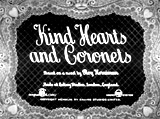


Kind Hearts and Coronets (1949, UK) (aka Noblesse Oblige), 106 minutes, D: Robert Hamer
The film was loosely based on Roy Harniman's 1907 novel Israel Rank: The Autobiography of a Criminal. The title was taken from a verse in Tennyson's 1942 poem Lady Clara Vere de Vere. In this morbid and ultra-black Ealing classic comedy about inheritance in Edwardian England by director Robert Hamer, the versatile Alec Guinness (in his third film role) starred with a virtuoso performance as all eight of the victimized members of the effete, aristocratic D'Ascoyne family (including Lady Agatha!) as they were killed one by one. All of the aristocratic family relatives were pictured in the title screen (young and old, and male and female -- a General, a snob, a young photographer, a suffragette, an Admiral, a Parson, a Banker and the Duke). The many heirs stood in the way of cold-blooded serial killer and impoverished, embittered commoner Louis Mazzini (Dennis Price) - a distant poor relative and the ninth in line to inherit the Dukedom of Chalfont. The scheming Mazzini's intent was to murder all the other rival successors and competing heirs, to become the new Duke of D'Ascoyne. Vengeful and greedy, and while in prison and about to be executed for a murder he didn't commit (of Lionel Holland (John Penrose)), he flashbacked to his earlier days ("In those days, I never had any trouble with the sixth commandment") and he told about his parents: his opera-singing father died when seeing his newborn child for the first time, while his disinherited, ostracized widowed mother (a member of the high-born D'Ascoyne family) was killed by a train (and refused a burial in the family vault at Chalfont). The murders occurred in this order: snobbish Ascoyne d'Ascoyne (by drowning in a boating accident), young Henry d'Ascoyne (by fire in a photographic darkroom), Reverend Lord Henry d'Ascoyne (The Parson) (by poison), suffragette Lady Agatha d'Ascoyne (by fall in hot-air balloon), Admiral Lord Horatio d'Ascoyne (The Admiral) (not murdered, died in naval accident), General Lord Rufus d'Ascoyne (The General) (by bomb explosion), Lord d'Ascoyne Ethelred (The Duke) (by gunshot while caught in a trap), and Lord Henry d'Ascoyne, Sr. (The Banker) (by fatal heart attack). In the satirical and memorable twist ending, Mazzini was released from prison to a cheering crowd (due to perjured testimony and a deal with the victim's widow Sibelia Holland (Joan Greenwood)). He was approached by a Tit-Bits reporter (Arthur Lowe) who asked: "I represent the magazine Tit-Bits by whom I'm commissioned to approach you for the publication rights of your memoirs." Mazzini paused for a second, then replied: "My memoirs? Oh, my memoirs. My memoirs" -- he glanced backward, and was reminded that he had left a self-incriminating memoirs document on his desk in his cell - the camera tracked back to his cell and the pile of his papers that would reveal his guilt.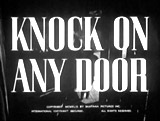



Knock on Any Door (1949), 100 minutes, D: Nicholas Ray
Nicholas Ray's 'social problem' drama was based upon the best-selling book by Willard Motley. Nick "Pretty Boy" Romano (John Derek), a mal-adjusted and frequent lawbreaker, was charged with the crime of robbery in the 380 Bar, and the cold-blooded murder of police Officer Dan Hawkins (Thomas Sully) during flight. Prominent Attorney Andrew Morton (Humphrey Bogart) reluctantly agreed to defend Romano, while the District Attorney was Kerman (George Macready). Judge Drake (Barry Kelly) presided. The DA argued that Romano was a black-hearted murderer that deserved to be executed. Morton, who grew up with the same hardship conditions as Romano, counter-argued with a simplistic defense plea that emphasized the evil of the slums, where Romano had been raised. In flashback, it was shown that years earlier, Morton's law firm had improperly defended Nick's innocent, Italian immigrant grocer father, who was sent to prison and died there. Romano's disadvantaged family was forced to move to the slums, where young disenfranchised Nick lived in poverty, was sent to a reform school, gambled himself into debt, met the wrong people, and joined a violent criminal gang. After Nick's wife Emma (Allene Roberts) became pregnant, he fled, and when he returned, he found that she had committed suicide (by asphyxiation in a gas oven). He turned to robbery and held up a train station. At the conclusion of his opening statements, slightly guilt-ridden Morton stated that Romano was not the murderer. DA Kerman summoned some unreliable, uncredible eyewitness to the stand who claimed they had seen Nick: (1) victimized 380 Bar bartender Carl Swanson (Vince Barnett), (2) homeless bum Kid Fingers Carnahan (Jimmy Conlin). Their testimonies were discredited by Morton. An accusatory statement by Juan Rodriguez (Pepe Hern) was obtained under duress - Rodriguez was coerced by being threatened with deportation by police. Two of Morton's witnesses provided Nick with an alibi - they were drinking beer at the time of the crime. Under fierce cross-examination on the stand, Nick (who shouldn't have been allowed to testify) caved to pressure by Kerman (who screamed "murderer" at him), especially when he was accused of causing his wife Emma's suicide. Romano broke down and confessed to the robbery and murder. In the final moments of the trial, liberal-minded attorney Morton emotionally pleaded for leniency and mercy from the jury regarding Nick's admission of guilt, arguing that his social upbringing and failures of the justice system had caused his life of crime, but his pleas were unsuccessful. Nick was sentenced to death (by electric chair) by the Judge.

On the Town (1949), 98 minutes, D: Gene Kelly and Stanley Donen
This fresh, energetic, kinetic and innovative landmark MGM musical was co-directed by Stanley Donen and dancer/choreographer Gene Kelly (together, they directed three MGM post-war musicals) - his directorial debut, featured lyrics by Betty Comden and Adolph Green, and Leonard Bernstein's music from the Broadway stage musical of 1944. This exuberant musical masterpiece won the Oscar for Best Musical Score. It took the musical out of the wall-bound studio and on location into New York City (with all the prominent sites) - the first time that actual locations were used for musical numbers. The movie was also noted as the third and final pairing of musical stars Gene Kelly and Frank Sinatra. Most of the film was composed of dances of a trio of sailors in the NYC streets (often with their three female companions joining with them). The sailors were always dressed in white, and each of the females was represented by a different color scheme - Claire (green), Hildy (yellow), and Ivy (pink). It opened with the show-stopping, two and a half-minute song-and-dance number "New York, New York (It's a Hell of a Town)." The lively musical was a story about three on-leave sailors, Gabey (Gene Kelly), shy Chip (Frank Sinatra) and Ozzie (Jules Munshin), who were looking for romance during a 24-hour shore leave/furlough after docking in the Brooklyn Navy Yard. Together, they experienced all the sights of the city with their new girlfriends: lust-crazed female Globe cab driver Hildy Esterhazy (Betty Garrett) (who advanced on the very shy Chip in "Come Up to My Place"), sexy toe-tapping anthropologist Claire Huddesen (Ann Miller) (whom Ozzie met in the fictional Museum of Anthropological History) where they performed the song/dance "Prehistoric Man" (also one of the museum's displays), and ballet dancer 'Miss Turnstiles' (subway ad 'dream girl'), actually named Ivy Smith (Vera-Ellen) - performed a traditional boy-meets-girl duet with Gabey in "Main Street," and later appeared with him in a stylized and innovative dream sequence titled "A Day in New York." The climactic title number "On the Town" was performed by the three couples on the Empire State Building's open rooftop and then on a wide street-level sidewalk. The final scene was the reunion between Gabey and Ivy on Coney Island where he found her performing as a cooch dancer at a Middle Eastern concession (in order to pay for her ballet lessons), before the three sailors dressed in drag to evade the police while being chased. They were captured by the shore patrol and taken back to their ship that was scheduled to depart at 6 AM (24 hours after their leave began). Fortunately, the three girlfriends caught up to them on the dock just before they left, and offered lots of kisses, embraces, and goodbye waves, with a reprise of "New York, New York" (by a new trio of sailors leaving the ship).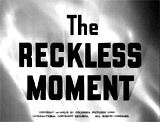


The Reckless Moment (1949), 82 minutes, D: Max Ophuls
Director Max Ophuls' taut domestic noirish 'woman's melodrama' and thriller, with stark shadowy cinematography (by Burnett Guffey), was his fourth and final Hollywood film before returning to Europe. Ophuls was known for trademark long and fluid takes, deep-focus, and subtle mise-en-scene. Slightly similar in theme to Mildred Pierce (1945), the story was adapted from Elisabeth Sanxay Holding's 1947 "The Blank Wall" originally published in the Ladies Home Journal. It was remade as The Deep End (2001), by Scott McGehee and David Siegel, with star Tilda Swinton. It was set in a small, sleepy beach-seaside community (Balboa) 50 miles from Los Angeles. Upper middle-class, chain-smoking, bespectacled, and sheltered housewife Lucia Harper (Joan Bennett) (with her patriarchal husband Tom (Henry O'Neill) noticeably absent and away on business in Berlin, Germany) mistakenly believed that her arrogant, nail-biting, and impetuous 17 year-old daughter Beatrice or "Bea" (Geraldine Brooks), an LA art school student, had killed her slimy, older lover Ted Darby (Shepperd Strudwick). In reality, Darby accidentally died (a case of manslaughter) during a clandestine meeting with Bea in a boathouse. When Bea angrily hit Darby in the head with a flashlight, he tripped, lost his balance and fell onto a large boat anchor. In a panic and "reckless moment," the determined, frantic, devoted and selfless mother (to defend her domesticity and family from scandal) dumped the body in a lagoon (with the anchor), but the corpse washed ashore and was discovered. Afterwards, suave, small-time Irish crook Martin Donnelly (James Mason in his third US film) visited Lucia to blackmail her (for $5,000 hush money), on behalf of his tough boss-partner Nagel (Roy Roberts), a loan shark with incriminating love letters that Bea had written to Ted. Although Martin soon became infatuated with Lucia, his dangerous and unprincipled partner continued to pressure him and demand payment. Feeling entrapped by lies and deception, neurotic woman-in-peril Lucia attempted to raise the funds (at first she was unsuccessful in securing a loan from a bank), and resorted to pawning her jewelry (for only $800), with Donnelly in tow. In the stirring conclusion, Donnelly decided to defend Lucia against Nagel. Although stabbed, Donnelly choked Nagel to death. As he was dying after a car crash during his departure, Donnelly returned the love letters and assured Lucia that he would take the blame for the deaths of Darby and Nagel. The film ended, as Lucia phoned her distant husband and assured him that everything would be fine once he returned home.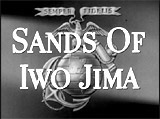
Sands of Iwo Jima (1949), 110 minutes, D: Allan Dwan


Director Allan Dwan's revisionistic, politically-correct, blatantly-patriotric, historically-inaccurate action-war drama was made after the war by Republic Studios. The film's backdrop was of the training and preparation required of the US Marine recruits before they landed on Iwo Jima in 1945. Specifically, it followed the conflicts that emerged between two individuals in particular, a war of words and values between Sgt. Stryker (Oscar-nominated John Wayne, his first Academy Award Best Actor nomination) and PFC Peter Conway (John Agar). The film's opening was accompanied by the playing and singing of the Marines' Hymn ("From the Halls of Montezuma To the shores of Tripoli..."), followed by an appreciative scrolling tribute to the brave members of the Marine Corps and for their help in the making of the film. Tough, battle-hardened and harsh Marine Sergeant John M. Stryker addressed his combat soldiers in New Zealand in 1943 - a new batch of rebellious greenhorn recruits-troops to fight in the Pacific theatre of the war as a rifle squad. Although he would exhaust the recruits with his rough training methods, the infamous commander was determined to mold them into fighting men; his strict expectations were echoed in his commands to a rifle squad. The gung-ho Stryker repeatedly used the phrase: "Saddle up!" to get his platoon of soldiers moving. One of Stryker's men was Pfc Peter Conway - the college-educated son of Colonel Sam Conway (Stryker's deceased former commanding officer at Guadalcanal) who was killed 10 months earlier. Conway felt that his commanding officer Stryker was similar to his demanding father, who had shamed him, thought he wasn't tough enough, and had considered him cowardly and inferior. The two often sparred with each other. Five years earlier, the hard-nosed Sgt. Stryker had separated from his wife Mary and now 10 year-old son (who failed to write to him), and had become embittered with life, when his ex-wife took full custody. He began drinking, and often took out his frustrations on the men under his command. During the brutal November 1943 assault on the Japanese base at Tarawa atoll, Stryker's unit landed on the beach head, but they were faced by non-stop machine-gunfire from a bunker that slaughtered many of the men. Stryker took it upon himself to single-handedly race forward, grab the satchel charges (from a downed soldier) and toss them into the bunker - and he successfully blew it up. Later that night as Stryker's men guarded the main approach to the beachhead, the faint voice of badly-wounded comrade Pfc. Charlie Bass (James Brown) could be heard calling out "Corpsman" and then "Stryker," but Stryker at first thought it might be a "Jap trick" and then feared that helping him would tip off their whereabouts to the Japanese enemy. Pfc Conway - who wanted to rescue Bass, was told by Stryker that he would be shot if he attempted a rescue. Ironically, Conway proved his manhood and worth by heroically saving Stryker's life during a difficult landing on the rocky cliffs of Japan's island of Iwo Jima, when Stryker was unexpectedly jumped by a Japanese soldier with a sword. Conway jumped in to defend Stryker by stabbing the enemy to death. Afterwards, the two established a strong friendship and bond. Conway also told Stryker that he was going to name his son Sam after his father: ("We're gonna name him Sam, Sam Conway"). In an unexpected scene, Stryker died an unheroic death from a random bullet. He had just completed the strategic assault on the volcanic Japanese island fortress of Iwo Jima, and had paused to relax with a cigarette after having just told fellow Marine Conway: "As a matter of fact, I never felt so good in my life." He was asking: "How about a cigarette?" - when he was shot and killed by a Japanese sniper in an underground spider hole. As Conway embraced Stryker's dead body, he discovered an undelivered and unfinished letter written by Stryker to explain himself to his son. It was a somber and dramatic moment as Conway emotionally read the letter out-loud. The letter abruptly ended unfinished: "I guess he never finished it," but Conway promised to finish it. The film's last line (accompanied by the singing of The Marines' Hymn) was delivered by Conway (using Stryker's words) - it was heard with the memorable raising of the flag ("There she goes") on Mount Suribachi in February of 1945: "All right! Saddle up! Let's get back in the war!"


She Wore a Yellow Ribbon (1949), 103 minutes, D: John Ford
This was the second of director John Ford's "cavalry trilogy" series (and his personal favorite, preceded by Fort Apache (1948) and followed by Rio Grande (1950) which were in black and white, and all starring John Wayne), filmed in his favorite scenic locale - Monument Valley. The RKO hit film was noted for Winton C. Hoch's beautiful Oscar-winning Technicolor cinematography (the film's sole nomination and win). Ford's autumnal and sentimental western starred John Wayne as an aging cavalry captain named Nathan Brittles, serving in 1876 at Fort Starke, a one-troop cavalry post. After Custer's Last Stand, an allied group of native Americans were on the warpath, including Arapaho and Cheyenne. In an early sunset scene, soon-to-be retired (in six days) Capt. Brittles sat at the gravestone of his deceased 33 year-old wife Mary Cutting Brittles and spoke to her while he watered the flowers. The fort was commanded by Major "Mac" Allshard (George O'Brien), who ordered Brittles (on his last patrol mission) to protectively accompany two women: his own no-nonsense wife Abby 'Old Iron Pants' Allshard (Mildred Natwick) and Mrs. Allshard's niece - attractive, genteel single lady Olivia Dandridge (Joanne Dru). They were being evacuated for their own safety to an awaiting stagecoach station at Sudro's Well to take an eastbound stagecoach. Olivia was being pursued by two rival lieutenants in the fort: Brittles' pending replacement Lieutenant Flint Cohill (John Agar) and arrogant 2nd Lieutenant Ross Pennell (Harry Carey, Jr.). She wore a 'yellow ribbon' in her hair signifying that she had chosen a "sweetheart" - although the two fought over her affections (Cohill). Captain Brittles was joined on the trip by Major Allshard, shrewd chief scout Sgt. Tyree (Ben Johnson), and often-drunk and comical First Sgt. Quincannon (Victor McLaglen). The women and the wagons slowed down their trip, and so did a detour when they had to give a "wide berth" to a group of migrating Arapahos. As the regiment approached the Sudro stage depot, they discovered that the Indians (a mixed group of Cheyenne and Arapaho) had massacred the stage master John Sudro and his wife Martha (leaving their two young children Palmer and Carey Sue orphaned), and lethally-wounded brave trooper Pvt. John Smith/Rome Clay (Rudy Bowman) who had helped to defend the depot. The patrol was forced to make an arduous, return march to the Fort, planned for the middle of the night. After returning to the fort, Captain Brittles told Maj. Allshard that he considered the mission that he had been leading a complete failure: "Failed at Sudro's. Failed to keep Rynders' rifles from the tribes. Failed at everything. I leave the Army a failure." On the next day, his last day before retirement in a farewell scene, Brittles' C Troop awarded him with a solid silver pocketwatch with the inscription: "To Captain Brittles. From C Troop Lest we forget" that he tearfully and proudly read with his glasses. With only four hours left before his retirement officially began, Capt. Brittles chose to intervene in an impending Indian war. Accompanied by Sgt. Tyree, Brittles met under a truce flag with his elderly friend - Cheyenne Indian Chief Pony That Walks (Chief John Big Tree), and vainly tried to dissuade the Indians from war. Brittles chose a risky strategy of stampeding the Indians' horses out of their camp just before midnight (and just before his civilian life officially began), to prevent battle in an inevitable and bloody war against US troops, and to force them to return to their reservation on foot. Then, although officially retired and heading westward, Brittles was recalled back to duty ("But the Army hadn't fiinished with Brittles") by the Yankee War Department - with a promotion as Lieutenant Colonel and appointment as Chief of the Civilian Scouts. The film ended with Brittles receiving praise from everyone at the fort. As a celebratory dance commenced, Brittles walked to the gravesite of his wife to quietly sit.




The Third Man (1949, UK), 100 minutes, D: Carol Reed
Carol Reed's British visually-stylish film noir thriller - a paranoid story of social, economic, and moral corruption - has been widely acclaimed as an effective suspenser and one of the best films of all-time. It was adapted from Graham Greene's novella written to prepare the film's screenplay, then later published. With a haunting zither musical score and theme from Anton Karas, and innovative b/w camera-work (by Robert Krasker) to accentuate the gloomy, depressed, rotting and sinister atmosphere. Unusually reckless, canted camera angles (one of their earliest uses), and wide-angle lens distortions amidst the atmospheric on-location views of a shadowy Vienna cast a somber mood over the fable of post-war moral ambiguity and ambivalent redemption. The deliberately unsettling, tilted angles reflected the state of the ruined, fractured and dark city - ravaged, crumbling and desperate during the Cold War, and split among the occupying forces. Vienna was also filled with black marketeers, spies, refugees, thieves, and foreign powers seeking control. A pulp Western novelist Holly Martins (Joseph Cotten) arrived in Vienna, totally broke and hoping to find employment. He was forced to assume the role of an amateur sleuth as he looked for old friend Harry Lime (Orson Welles) who had reportedly been killed in Vienna in a car accident days earlier - although there were mysterious circumstances surrounding the incident. He sought to unravel the mystery of the presumed-dead friend with a probing search, and an infatuation with Lime's actress girlfriend Anna Schmidt (Alida Valli). The first appearance of Lime was in a doorway, as a light suddenly illuminated his sardonic smile. He ultimately learned that Lime was a vile, unscrupulous and notorious black-market drug dealer who preyed on the sick with diluted penicillin. The great thriller included the dramatic scene atop a ferris wheel (with the famed "Swiss cuckoo clock" dialogue), a suspenseful manhunt led by Major Calloway (Trevor Howard) into the underground city sewers for Lime - a shadowy, marked man, and the famed ending of Anna's stoic shunning of Martins on a cemetery road while remaining loyal to Lime.


Twelve O'Clock High (1949), 132 minutes, D: Henry King
This great and realistic war film about leadership was a superb and enthralling character study emphasizing the stress encountered by various WWII officers who led US forces into combat. Although effective against the German Nazis, the heavy bombing raids in a hot combat zone took a horrendous, self-destructive, emotional and physical toll on fliers and aircraft. The terrifying and dangerous air raids were dramatically photographed in numerous aerial sequences. This timely, tense and compelling film was told in flashback (from the year 1949, looking back to 1942) by middle-aged, introspective American tourist Harvey Stovall (Dean Jagger) who was visiting an abandoned airstrip in England. Years earlier, he had served with the struggling 918th Bomb Group (of the US Eighth Air Force) of B-12 bombers based at Archbury, England in late 1942. He recalled when Brig. Gen. Frank Savage (Gregory Peck), a tough, hard-as-nails, discipline-oriented commander was assigned to the unit. [Note: Peck's character was based on Colonel Frank Armstrong, Jr. whose exploits in whipping into shape the real-life 306th Bombardment Group at Thurleigh Field in England were documented in the 1948 novel of the same name by the film's scriptwriters Sy Bartlett and Beirne Lay, Jr.] Known as a very strict, harsh and by-the-book officer, Savage replaced compassionate, soft-hearted but popular predecessor Colonel Keith Davenport (Gary Merrill) who had been relieved of his duty after resisting to send his men on another near-suicidal, low-altitude daytime mission. At first, the scarred, hard-luck men with low morale resented and detested the personal style of their stern replacement commander who insisted on discipline, and many of them threatened to be transferred. However, they gradually learned to respect him. Over time, Savage began to over-identify with his beleaguered men, and suffered from the same effects that doomed Davenport. In the stressful atmosphere of uncertainty, risk and danger, he began to act erratically, went into shock and had a nervous breakdown during a mission.



Whisky Galore! (1949, UK) (aka Tight Little Island), D: Alexander Mackendrick
Alexander Mackendrick's directorial debut film came with this Ealing Studios release - a droll, fast-paced, black-and-white British comedy that was well-revered, based on the light-hearted 1947 novel by Scottish novelist Compton Mackenzie. It was based upon a true story of a sunken ship in early 1941. The odd comedy told about a cargo of whiskey, 50,000 cases, on the steamship freighter SS Cabinet Minister that was shipwrecked in heavy fog off the rocky and remote Scottish Hebrides island of Todday during WWII - the tagline described: "It's Light... It's Bright... It's 100 Proof!" The tempted and thirsty locals during a time of war rationing, salvaged some of the precious cargo, smuggled it to the island, and concealed it. Among those who were enlivened by the cargo were the town's teetotalling, henpecked schoolteacher George Campbell (Gordon Jackson), his strict and domineering Calvinist mother Mrs. Campbell (Jean Cadell), and dying hermit Old Hector (James Anderson). They and other wily townsfolk made numerous devious attempts to circumvent the British customs revenue officials, led by stuffy, bureaucratic and pompous Home Guard Captain Paul Waggett (Basil Radford), who wanted to confiscate the find. A cat-and-mouse game distracted the authorities, and allowed the islanders to triumphantly keep their prized drink. In the film's moral epilogue, however, it was announced that the whiskey soon dried up, and the Todday islanders lived 'unhappily' ever after.


White Heat (1949), 114 minutes, D: Raoul Walsh
Director Walsh's very volatile, super-charged and compelling, film-noirish gangster-crime film (one of the best ever made) was one of the last of Warner Bros.' gangster films - a full decade after their proliferation in the 1930s. The classic film anticipated the heist films of the early '50s (e.g., John Huston's The Asphalt Jungle (1950) and Stanley Kubrick's The Killing (1956)), accentuated the semi-documentary style of films of the period (e.g., The Naked City (1948)), and contained film-noirish elements, including the shady black-and-white cinematography, the femme fatale character, and the twisted psyche of the criminal gangster. The crime drama told about a psychopathic, homicidal, mother-devoted gangster. Crazed, eccentric, and tough-guy killer Arthur "Cody" Jarrett (James Cagney in one of his finest career performances) led a gang of train robbers in the High Sierras, while unnaturally and obsessively aided by the ministrations of his beloved, equally crooked and shrewd "Ma" Jarrett (Margaret Wycherly), the only female he truly loved, and the only one who could console him during excruciatingly-painful bouts of headaches. His treacherous wife Verna (Virginia Mayo) was unfaithful with rebellious gang member "Big Ed" Somers (Steve Cochran), amidst gang dissension, when Cody was briefly imprisoned in the Illinois State Penitentiary. When he learned of his mother's death, the mother-fixated, violent and warped Cody went beserk in the prison cafeteria. After an escape from prison during a riot, he fled to Southern California, where Verna assured him that "Big Ed" had shot and killed his mother (although she had committed the deed) - and Cody gunned him down. Then, during the payroll robbery of an oil refinery and chemical plant in Long Beach, Cody was betrayed by clever undercover agent/informant Vic Pardo/Hank Fallon (Edmond O'Brien). In the legendary blazing finale, a trapped Cody was consumed in the flames of a round-shaped holding tank explosion (from his own gunfire) as he proclaimed: "Made it Ma! Top of the world!"